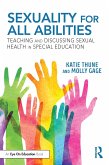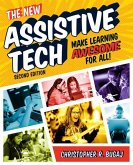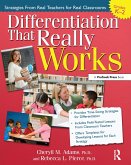Joan L Green
Assistive Technology in Special Education
Resources to Support Literacy, Communication, and Learning Differences
Joan L Green
Assistive Technology in Special Education
Resources to Support Literacy, Communication, and Learning Differences
- Broschiertes Buch
- Merkliste
- Auf die Merkliste
- Bewerten Bewerten
- Teilen
- Produkt teilen
- Produkterinnerung
- Produkterinnerung
Assistive Technology in Special Education presents a wealth of practical, well-organized information to help families, teachers, and therapists find effective solutions for students with learning, literacy, and cognitive challenges.
Andere Kunden interessierten sich auch für
![Assistive Technologies for Differently Abled Students Assistive Technologies for Differently Abled Students]() Assistive Technologies for Differently Abled Students180,99 €
Assistive Technologies for Differently Abled Students180,99 €![Assistive Technology for Young Children: Creating Inclusive Learning Environments [With CDROM] Assistive Technology for Young Children: Creating Inclusive Learning Environments [With CDROM]]() Kathleen SadaoAssistive Technology for Young Children: Creating Inclusive Learning Environments [With CDROM]45,99 €
Kathleen SadaoAssistive Technology for Young Children: Creating Inclusive Learning Environments [With CDROM]45,99 €![Sexuality for All Abilities Sexuality for All Abilities]() Katie ThuneSexuality for All Abilities49,99 €
Katie ThuneSexuality for All Abilities49,99 €![The New Assistive Tech, Second Edition The New Assistive Tech, Second Edition]() Christopher BugajThe New Assistive Tech, Second Edition42,99 €
Christopher BugajThe New Assistive Tech, Second Edition42,99 €![Differentiation That Really Works Differentiation That Really Works]() Cheryll M AdamsDifferentiation That Really Works23,99 €
Cheryll M AdamsDifferentiation That Really Works23,99 €![How to Create Successful Special Education Team Meetings: A Guide for Case Managers How to Create Successful Special Education Team Meetings: A Guide for Case Managers]() Robert ScobieHow to Create Successful Special Education Team Meetings: A Guide for Case Managers16,99 €
Robert ScobieHow to Create Successful Special Education Team Meetings: A Guide for Case Managers16,99 €![Redesigning Special Education Teacher Preparation Redesigning Special Education Teacher Preparation]() Redesigning Special Education Teacher Preparation57,99 €
Redesigning Special Education Teacher Preparation57,99 €-
-
-
Assistive Technology in Special Education presents a wealth of practical, well-organized information to help families, teachers, and therapists find effective solutions for students with learning, literacy, and cognitive challenges.
Hinweis: Dieser Artikel kann nur an eine deutsche Lieferadresse ausgeliefert werden.
Hinweis: Dieser Artikel kann nur an eine deutsche Lieferadresse ausgeliefert werden.
Produktdetails
- Produktdetails
- Verlag: Taylor & Francis Ltd (Sales)
- 3rd edition
- Seitenzahl: 254
- Erscheinungstermin: 30. Mai 2018
- Englisch
- Abmessung: 254mm x 174mm x 17mm
- Gewicht: 451g
- ISBN-13: 9781618217585
- ISBN-10: 1618217585
- Artikelnr.: 49359391
- Herstellerkennzeichnung
- Libri GmbH
- Europaallee 1
- 36244 Bad Hersfeld
- gpsr@libri.de
- Verlag: Taylor & Francis Ltd (Sales)
- 3rd edition
- Seitenzahl: 254
- Erscheinungstermin: 30. Mai 2018
- Englisch
- Abmessung: 254mm x 174mm x 17mm
- Gewicht: 451g
- ISBN-13: 9781618217585
- ISBN-10: 1618217585
- Artikelnr.: 49359391
- Herstellerkennzeichnung
- Libri GmbH
- Europaallee 1
- 36244 Bad Hersfeld
- gpsr@libri.de
Joan Green is a speech-language pathologist in the Washington, DC, area with many years of experience helping children and adults who have a wide range of communication, cognitive, literacy and learning challenges. She is passionate in her efforts to spread the word about how affordable cutting-edge technology can be used to empower children and adults who have difficulty with speaking, reading, writing, thinking, and learning at home, school, work, or in the community.
Acknowledgements Notes on the Third Edition Chapter 1 Getting Started With
Assistive Technology Improving Technologies Offer Hope What Is Assistive
Technology? Helpful Technologies All Around Us Taking the First Steps
Seeking Professional Guidance How to Get Help What Solution Is "Best"?
Chapter 2 The Benefits of Assistive Technology Changing Technology Trends
Remaining Barriers to Technology The Many Benefits of Assistive Technology
Who Can Benefit From Assistive Technology? Family Advocacy Technology
Changes Will Continue Accessing Features in Devices You Already Use Chapter
3 Lifting the Barriers: Technology and Access Ease of Access Guidance for
Computer Access and Assistive Technologies Use of Switch Software Which
Type of Device Should You Use? Selection Devices Keyboards Speech
Input/Dictation Chapter 4 Technology and Strategies to Improve Verbal
Expression A Professional Diagnosis Is Critical Strategies to Encourage
Verbal Expression Informative Online Resources Helpful Technology Tools Be
Creative Improving Verbal Expression Skills Improving Speech
Intelligibility Improving Expressive Language Improving Word Knowledge and
Retrieval Strategies and Technologies to Improve Speaking in Phrases and
Sentences Strategies and Technologies to Improve Dialogue and Engaging in
Conversation Chapter 5 Augmentative and Alternative Communication: Devices,
Apps, and More What Is Augmentative and Alternative Communication (AAC)?
Individuals Helped by AAC Current AAC Trends First Steps Resources to Learn
More About AAC Simple Communication Items Without Voice Output
Direct-Select, One-Level, Voice Output Communication Devices Mobile Device
Apps With Static Display Dynamic Communication Devices, Apps, and Software
Dynamic Display Communication Mobile Apps Smartphones Chapter 6 Technology
and Strategies to Improve Auditory Comprehension and Receptive Language
Treatment Approach Technology to Help Improve Auditory Comprehension Sound
Discrimination Comprehension of Words Comprehension of Phrases and
Sentences Comprehension of Paragraphs and Short Stories Websites With Free
Listening Activities Improving Comprehension With Text-to-Speech Support
While Reading Long-Distance Communication Assistive Listening Devices
Captioning Chapter 7 Technology and Strategies to Improve Reading
Comprehension Reading Challenges Help From Professionals and Websites
Helpful Features of Technology to Support Reading Text to Speech Optical
Character Recognition Advanced Text Readers With Reading,Writing, and
Studying Tools Alternative Reading Formats, Interactive Websites,and Apps
With Accessible Books Portable eBook Readers Handheld Devices That Read
Aloud Chapter 8 Drill-and-Practice Technology toImprove Reading Skills
Interactive Software and Apps With Activities to Improve Reading Online
Programs Mobile Apps to Improve Language-Based Reading Deficits Software
for Vision-Based Reading Deficits Chapter 9 Technology and Strategies to
Improve Written Expression Skills Needed for Writing Handwriting Use of
Assistive Technology With Students Selection of an Effective Assistive
Writing Technology Word Processing Systems Specialized Assistive Tools for
Spelling, Grammar, and Word Prediction Digitizing Paper-Based Worksheets
Annotating or Typing on PDFs (Worksheets) Taking Notes Presentations for
Teaching and Learning Story Creators Graphic Organizers: Technology for
Organizing Written Narrative Technology to Support Writing Essays and
Reports Technology to Help With the Physical Act of Writing and Typing
Alternative Input Devices Alternatives for Mobile Touchscreen Input Speech
to Text/Speech Recognition Chapter 10 Drill-and-Practice Technology to
Improve Writing Skills Prewriting Skills and Writing Letters of the
Alphabet Writing Words/Spelling Programs and Apps for Writing Sentences and
Improving Grammar Typing Chapter 11 Technology and Strategies to Improve
Attention, Cognition, and Executive Function Cognitive Differences
Professional Evaluation Strategies to Enhance Learning Practicing Specific
Skills Compensatory Approach General Guidelines to Enhance Learning,
Organization, and Executive Function Time Management Tools: Calendars and
To-Do Lists Selection of Technologies to Support Time Management Task
Management and To-Do Apps Visual Schedule and Choice Apps for Individuals
With Complex Cognitive Challenges Non-App Devices to Help Students Stay on
Task Limit Distractions Minimize the Power Struggle Chapter 12 Tools and
Strategies to Support Learning New Information Reducing Digital Distraction
Audio Recordings of Lectures Synced to Written Material Mobile Device Apps
Digital Flash Card Programs Study Guides Learning by Watching Online Videos
Interactive Whiteboard Apps Use of Images to Support Learning Chapter 13
Online Organization and Collaboration Online Storage Digital Bookmarking
Tools Online Collaboration Video Chatting Chapter 14 Interactive Programs
to Practice Cognitive Skills Use of Apps and Online Programs to Improve
Skills Brain Training Online Programs and Apps to Improve Specific
Cognitive Skills Early Learning Skills Learning Cause and Effect Chapter 15
Final Thoughts: Keeping Students Safe and Preparing for the Future With the
Good Comes the Bad Tools to Promote Digital Citizenship and Safety Current
Tech Trends New Solutions References About the Author Index
Assistive Technology Improving Technologies Offer Hope What Is Assistive
Technology? Helpful Technologies All Around Us Taking the First Steps
Seeking Professional Guidance How to Get Help What Solution Is "Best"?
Chapter 2 The Benefits of Assistive Technology Changing Technology Trends
Remaining Barriers to Technology The Many Benefits of Assistive Technology
Who Can Benefit From Assistive Technology? Family Advocacy Technology
Changes Will Continue Accessing Features in Devices You Already Use Chapter
3 Lifting the Barriers: Technology and Access Ease of Access Guidance for
Computer Access and Assistive Technologies Use of Switch Software Which
Type of Device Should You Use? Selection Devices Keyboards Speech
Input/Dictation Chapter 4 Technology and Strategies to Improve Verbal
Expression A Professional Diagnosis Is Critical Strategies to Encourage
Verbal Expression Informative Online Resources Helpful Technology Tools Be
Creative Improving Verbal Expression Skills Improving Speech
Intelligibility Improving Expressive Language Improving Word Knowledge and
Retrieval Strategies and Technologies to Improve Speaking in Phrases and
Sentences Strategies and Technologies to Improve Dialogue and Engaging in
Conversation Chapter 5 Augmentative and Alternative Communication: Devices,
Apps, and More What Is Augmentative and Alternative Communication (AAC)?
Individuals Helped by AAC Current AAC Trends First Steps Resources to Learn
More About AAC Simple Communication Items Without Voice Output
Direct-Select, One-Level, Voice Output Communication Devices Mobile Device
Apps With Static Display Dynamic Communication Devices, Apps, and Software
Dynamic Display Communication Mobile Apps Smartphones Chapter 6 Technology
and Strategies to Improve Auditory Comprehension and Receptive Language
Treatment Approach Technology to Help Improve Auditory Comprehension Sound
Discrimination Comprehension of Words Comprehension of Phrases and
Sentences Comprehension of Paragraphs and Short Stories Websites With Free
Listening Activities Improving Comprehension With Text-to-Speech Support
While Reading Long-Distance Communication Assistive Listening Devices
Captioning Chapter 7 Technology and Strategies to Improve Reading
Comprehension Reading Challenges Help From Professionals and Websites
Helpful Features of Technology to Support Reading Text to Speech Optical
Character Recognition Advanced Text Readers With Reading,Writing, and
Studying Tools Alternative Reading Formats, Interactive Websites,and Apps
With Accessible Books Portable eBook Readers Handheld Devices That Read
Aloud Chapter 8 Drill-and-Practice Technology toImprove Reading Skills
Interactive Software and Apps With Activities to Improve Reading Online
Programs Mobile Apps to Improve Language-Based Reading Deficits Software
for Vision-Based Reading Deficits Chapter 9 Technology and Strategies to
Improve Written Expression Skills Needed for Writing Handwriting Use of
Assistive Technology With Students Selection of an Effective Assistive
Writing Technology Word Processing Systems Specialized Assistive Tools for
Spelling, Grammar, and Word Prediction Digitizing Paper-Based Worksheets
Annotating or Typing on PDFs (Worksheets) Taking Notes Presentations for
Teaching and Learning Story Creators Graphic Organizers: Technology for
Organizing Written Narrative Technology to Support Writing Essays and
Reports Technology to Help With the Physical Act of Writing and Typing
Alternative Input Devices Alternatives for Mobile Touchscreen Input Speech
to Text/Speech Recognition Chapter 10 Drill-and-Practice Technology to
Improve Writing Skills Prewriting Skills and Writing Letters of the
Alphabet Writing Words/Spelling Programs and Apps for Writing Sentences and
Improving Grammar Typing Chapter 11 Technology and Strategies to Improve
Attention, Cognition, and Executive Function Cognitive Differences
Professional Evaluation Strategies to Enhance Learning Practicing Specific
Skills Compensatory Approach General Guidelines to Enhance Learning,
Organization, and Executive Function Time Management Tools: Calendars and
To-Do Lists Selection of Technologies to Support Time Management Task
Management and To-Do Apps Visual Schedule and Choice Apps for Individuals
With Complex Cognitive Challenges Non-App Devices to Help Students Stay on
Task Limit Distractions Minimize the Power Struggle Chapter 12 Tools and
Strategies to Support Learning New Information Reducing Digital Distraction
Audio Recordings of Lectures Synced to Written Material Mobile Device Apps
Digital Flash Card Programs Study Guides Learning by Watching Online Videos
Interactive Whiteboard Apps Use of Images to Support Learning Chapter 13
Online Organization and Collaboration Online Storage Digital Bookmarking
Tools Online Collaboration Video Chatting Chapter 14 Interactive Programs
to Practice Cognitive Skills Use of Apps and Online Programs to Improve
Skills Brain Training Online Programs and Apps to Improve Specific
Cognitive Skills Early Learning Skills Learning Cause and Effect Chapter 15
Final Thoughts: Keeping Students Safe and Preparing for the Future With the
Good Comes the Bad Tools to Promote Digital Citizenship and Safety Current
Tech Trends New Solutions References About the Author Index
Acknowledgements Notes on the Third Edition Chapter 1 Getting Started With
Assistive Technology Improving Technologies Offer Hope What Is Assistive
Technology? Helpful Technologies All Around Us Taking the First Steps
Seeking Professional Guidance How to Get Help What Solution Is "Best"?
Chapter 2 The Benefits of Assistive Technology Changing Technology Trends
Remaining Barriers to Technology The Many Benefits of Assistive Technology
Who Can Benefit From Assistive Technology? Family Advocacy Technology
Changes Will Continue Accessing Features in Devices You Already Use Chapter
3 Lifting the Barriers: Technology and Access Ease of Access Guidance for
Computer Access and Assistive Technologies Use of Switch Software Which
Type of Device Should You Use? Selection Devices Keyboards Speech
Input/Dictation Chapter 4 Technology and Strategies to Improve Verbal
Expression A Professional Diagnosis Is Critical Strategies to Encourage
Verbal Expression Informative Online Resources Helpful Technology Tools Be
Creative Improving Verbal Expression Skills Improving Speech
Intelligibility Improving Expressive Language Improving Word Knowledge and
Retrieval Strategies and Technologies to Improve Speaking in Phrases and
Sentences Strategies and Technologies to Improve Dialogue and Engaging in
Conversation Chapter 5 Augmentative and Alternative Communication: Devices,
Apps, and More What Is Augmentative and Alternative Communication (AAC)?
Individuals Helped by AAC Current AAC Trends First Steps Resources to Learn
More About AAC Simple Communication Items Without Voice Output
Direct-Select, One-Level, Voice Output Communication Devices Mobile Device
Apps With Static Display Dynamic Communication Devices, Apps, and Software
Dynamic Display Communication Mobile Apps Smartphones Chapter 6 Technology
and Strategies to Improve Auditory Comprehension and Receptive Language
Treatment Approach Technology to Help Improve Auditory Comprehension Sound
Discrimination Comprehension of Words Comprehension of Phrases and
Sentences Comprehension of Paragraphs and Short Stories Websites With Free
Listening Activities Improving Comprehension With Text-to-Speech Support
While Reading Long-Distance Communication Assistive Listening Devices
Captioning Chapter 7 Technology and Strategies to Improve Reading
Comprehension Reading Challenges Help From Professionals and Websites
Helpful Features of Technology to Support Reading Text to Speech Optical
Character Recognition Advanced Text Readers With Reading,Writing, and
Studying Tools Alternative Reading Formats, Interactive Websites,and Apps
With Accessible Books Portable eBook Readers Handheld Devices That Read
Aloud Chapter 8 Drill-and-Practice Technology toImprove Reading Skills
Interactive Software and Apps With Activities to Improve Reading Online
Programs Mobile Apps to Improve Language-Based Reading Deficits Software
for Vision-Based Reading Deficits Chapter 9 Technology and Strategies to
Improve Written Expression Skills Needed for Writing Handwriting Use of
Assistive Technology With Students Selection of an Effective Assistive
Writing Technology Word Processing Systems Specialized Assistive Tools for
Spelling, Grammar, and Word Prediction Digitizing Paper-Based Worksheets
Annotating or Typing on PDFs (Worksheets) Taking Notes Presentations for
Teaching and Learning Story Creators Graphic Organizers: Technology for
Organizing Written Narrative Technology to Support Writing Essays and
Reports Technology to Help With the Physical Act of Writing and Typing
Alternative Input Devices Alternatives for Mobile Touchscreen Input Speech
to Text/Speech Recognition Chapter 10 Drill-and-Practice Technology to
Improve Writing Skills Prewriting Skills and Writing Letters of the
Alphabet Writing Words/Spelling Programs and Apps for Writing Sentences and
Improving Grammar Typing Chapter 11 Technology and Strategies to Improve
Attention, Cognition, and Executive Function Cognitive Differences
Professional Evaluation Strategies to Enhance Learning Practicing Specific
Skills Compensatory Approach General Guidelines to Enhance Learning,
Organization, and Executive Function Time Management Tools: Calendars and
To-Do Lists Selection of Technologies to Support Time Management Task
Management and To-Do Apps Visual Schedule and Choice Apps for Individuals
With Complex Cognitive Challenges Non-App Devices to Help Students Stay on
Task Limit Distractions Minimize the Power Struggle Chapter 12 Tools and
Strategies to Support Learning New Information Reducing Digital Distraction
Audio Recordings of Lectures Synced to Written Material Mobile Device Apps
Digital Flash Card Programs Study Guides Learning by Watching Online Videos
Interactive Whiteboard Apps Use of Images to Support Learning Chapter 13
Online Organization and Collaboration Online Storage Digital Bookmarking
Tools Online Collaboration Video Chatting Chapter 14 Interactive Programs
to Practice Cognitive Skills Use of Apps and Online Programs to Improve
Skills Brain Training Online Programs and Apps to Improve Specific
Cognitive Skills Early Learning Skills Learning Cause and Effect Chapter 15
Final Thoughts: Keeping Students Safe and Preparing for the Future With the
Good Comes the Bad Tools to Promote Digital Citizenship and Safety Current
Tech Trends New Solutions References About the Author Index
Assistive Technology Improving Technologies Offer Hope What Is Assistive
Technology? Helpful Technologies All Around Us Taking the First Steps
Seeking Professional Guidance How to Get Help What Solution Is "Best"?
Chapter 2 The Benefits of Assistive Technology Changing Technology Trends
Remaining Barriers to Technology The Many Benefits of Assistive Technology
Who Can Benefit From Assistive Technology? Family Advocacy Technology
Changes Will Continue Accessing Features in Devices You Already Use Chapter
3 Lifting the Barriers: Technology and Access Ease of Access Guidance for
Computer Access and Assistive Technologies Use of Switch Software Which
Type of Device Should You Use? Selection Devices Keyboards Speech
Input/Dictation Chapter 4 Technology and Strategies to Improve Verbal
Expression A Professional Diagnosis Is Critical Strategies to Encourage
Verbal Expression Informative Online Resources Helpful Technology Tools Be
Creative Improving Verbal Expression Skills Improving Speech
Intelligibility Improving Expressive Language Improving Word Knowledge and
Retrieval Strategies and Technologies to Improve Speaking in Phrases and
Sentences Strategies and Technologies to Improve Dialogue and Engaging in
Conversation Chapter 5 Augmentative and Alternative Communication: Devices,
Apps, and More What Is Augmentative and Alternative Communication (AAC)?
Individuals Helped by AAC Current AAC Trends First Steps Resources to Learn
More About AAC Simple Communication Items Without Voice Output
Direct-Select, One-Level, Voice Output Communication Devices Mobile Device
Apps With Static Display Dynamic Communication Devices, Apps, and Software
Dynamic Display Communication Mobile Apps Smartphones Chapter 6 Technology
and Strategies to Improve Auditory Comprehension and Receptive Language
Treatment Approach Technology to Help Improve Auditory Comprehension Sound
Discrimination Comprehension of Words Comprehension of Phrases and
Sentences Comprehension of Paragraphs and Short Stories Websites With Free
Listening Activities Improving Comprehension With Text-to-Speech Support
While Reading Long-Distance Communication Assistive Listening Devices
Captioning Chapter 7 Technology and Strategies to Improve Reading
Comprehension Reading Challenges Help From Professionals and Websites
Helpful Features of Technology to Support Reading Text to Speech Optical
Character Recognition Advanced Text Readers With Reading,Writing, and
Studying Tools Alternative Reading Formats, Interactive Websites,and Apps
With Accessible Books Portable eBook Readers Handheld Devices That Read
Aloud Chapter 8 Drill-and-Practice Technology toImprove Reading Skills
Interactive Software and Apps With Activities to Improve Reading Online
Programs Mobile Apps to Improve Language-Based Reading Deficits Software
for Vision-Based Reading Deficits Chapter 9 Technology and Strategies to
Improve Written Expression Skills Needed for Writing Handwriting Use of
Assistive Technology With Students Selection of an Effective Assistive
Writing Technology Word Processing Systems Specialized Assistive Tools for
Spelling, Grammar, and Word Prediction Digitizing Paper-Based Worksheets
Annotating or Typing on PDFs (Worksheets) Taking Notes Presentations for
Teaching and Learning Story Creators Graphic Organizers: Technology for
Organizing Written Narrative Technology to Support Writing Essays and
Reports Technology to Help With the Physical Act of Writing and Typing
Alternative Input Devices Alternatives for Mobile Touchscreen Input Speech
to Text/Speech Recognition Chapter 10 Drill-and-Practice Technology to
Improve Writing Skills Prewriting Skills and Writing Letters of the
Alphabet Writing Words/Spelling Programs and Apps for Writing Sentences and
Improving Grammar Typing Chapter 11 Technology and Strategies to Improve
Attention, Cognition, and Executive Function Cognitive Differences
Professional Evaluation Strategies to Enhance Learning Practicing Specific
Skills Compensatory Approach General Guidelines to Enhance Learning,
Organization, and Executive Function Time Management Tools: Calendars and
To-Do Lists Selection of Technologies to Support Time Management Task
Management and To-Do Apps Visual Schedule and Choice Apps for Individuals
With Complex Cognitive Challenges Non-App Devices to Help Students Stay on
Task Limit Distractions Minimize the Power Struggle Chapter 12 Tools and
Strategies to Support Learning New Information Reducing Digital Distraction
Audio Recordings of Lectures Synced to Written Material Mobile Device Apps
Digital Flash Card Programs Study Guides Learning by Watching Online Videos
Interactive Whiteboard Apps Use of Images to Support Learning Chapter 13
Online Organization and Collaboration Online Storage Digital Bookmarking
Tools Online Collaboration Video Chatting Chapter 14 Interactive Programs
to Practice Cognitive Skills Use of Apps and Online Programs to Improve
Skills Brain Training Online Programs and Apps to Improve Specific
Cognitive Skills Early Learning Skills Learning Cause and Effect Chapter 15
Final Thoughts: Keeping Students Safe and Preparing for the Future With the
Good Comes the Bad Tools to Promote Digital Citizenship and Safety Current
Tech Trends New Solutions References About the Author Index

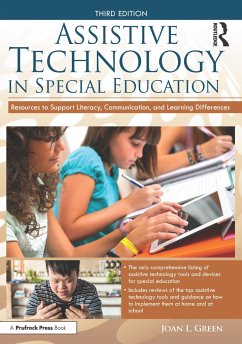
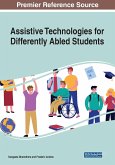
![Assistive Technology for Young Children: Creating Inclusive Learning Environments [With CDROM] Assistive Technology for Young Children: Creating Inclusive Learning Environments [With CDROM]](https://bilder.buecher.de/produkte/30/30513/30513131m.jpg)
